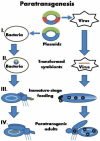Paratransgenesis
Paratransgenesis is an innovative approach in the field of biotechnology and genetic engineering aimed at controlling insect-borne diseases. This method involves the genetic modification of symbiotic microorganisms living within the host insect to render the insect incapable of transmitting diseases. Paratransgenesis is particularly significant in the fight against diseases such as malaria, dengue fever, and Chagas disease, which are spread by insects like mosquitoes and triatomine bugs.
Overview[edit | edit source]
The concept of paratransgenesis is based on the understanding that many insects, especially those that are vectors for human diseases, harbor symbiotic microorganisms. These microorganisms can be bacteria, viruses, or fungi that live in a mutualistic relationship with their host. By genetically modifying these symbionts to either disrupt the lifecycle of the pathogen within the vector or to enhance the insect's immune response against the pathogen, it is possible to reduce or eliminate the transmission of the disease to humans.
Methodology[edit | edit source]
The methodology of paratransgenesis involves several key steps:
- Identification of a suitable symbiotic microorganism that has a significant interaction with the target pathogen or the vector's physiology.
- Genetic modification of the identified symbiont to express anti-pathogenic traits. This could involve the introduction of genes that produce molecules toxic to the pathogen or that interfere with the pathogen's ability to reproduce or develop within the vector.
- Introduction of the genetically modified symbionts back into the vector population. This can be achieved through various means, including feeding the insects with a solution containing the modified microorganisms.
Applications[edit | edit source]
Paratransgenesis has potential applications in controlling various vector-borne diseases:
- Malaria Control: Modifying bacteria in the gut of Anopheles mosquitoes to either kill the malaria parasite or inhibit its development.
- Dengue Fever Prevention: Engineering symbiotic bacteria in Aedes mosquitoes to block the transmission of the dengue virus.
- Chagas Disease Mitigation: Altering the gut microbiota of the triatomine bugs to prevent the transmission of Trypanosoma cruzi, the causative agent of Chagas disease.
Challenges and Considerations[edit | edit source]
While paratransgenesis offers a promising avenue for disease control, there are several challenges and ethical considerations:
- Gene Transfer Risks: There is a potential risk of the engineered genes transferring to non-target organisms, leading to unintended ecological consequences.
- Stability of Modification: Ensuring the stability and persistence of the genetic modification within the symbiont and vector populations over time is crucial for the long-term success of this strategy.
- Regulatory and Ethical Issues: The release of genetically modified organisms into the environment raises regulatory and ethical questions that need to be addressed.
Future Directions[edit | edit source]
Research in paratransgenesis is ongoing, with scientists exploring more efficient ways to introduce genetic modifications into symbionts and to ensure the spread and maintenance of these modifications in wild vector populations. The development of new genetic tools and a deeper understanding of vector biology and vector-pathogen interactions will likely enhance the effectiveness and applicability of paratransgenesis in disease control.
Search WikiMD
Ad.Tired of being Overweight? Try W8MD's physician weight loss program.
Semaglutide (Ozempic / Wegovy and Tirzepatide (Mounjaro / Zepbound) available.
Advertise on WikiMD
|
WikiMD's Wellness Encyclopedia |
| Let Food Be Thy Medicine Medicine Thy Food - Hippocrates |
Translate this page: - East Asian
中文,
日本,
한국어,
South Asian
हिन्दी,
தமிழ்,
తెలుగు,
Urdu,
ಕನ್ನಡ,
Southeast Asian
Indonesian,
Vietnamese,
Thai,
မြန်မာဘာသာ,
বাংলা
European
español,
Deutsch,
français,
Greek,
português do Brasil,
polski,
română,
русский,
Nederlands,
norsk,
svenska,
suomi,
Italian
Middle Eastern & African
عربى,
Turkish,
Persian,
Hebrew,
Afrikaans,
isiZulu,
Kiswahili,
Other
Bulgarian,
Hungarian,
Czech,
Swedish,
മലയാളം,
मराठी,
ਪੰਜਾਬੀ,
ગુજરાતી,
Portuguese,
Ukrainian
Medical Disclaimer: WikiMD is not a substitute for professional medical advice. The information on WikiMD is provided as an information resource only, may be incorrect, outdated or misleading, and is not to be used or relied on for any diagnostic or treatment purposes. Please consult your health care provider before making any healthcare decisions or for guidance about a specific medical condition. WikiMD expressly disclaims responsibility, and shall have no liability, for any damages, loss, injury, or liability whatsoever suffered as a result of your reliance on the information contained in this site. By visiting this site you agree to the foregoing terms and conditions, which may from time to time be changed or supplemented by WikiMD. If you do not agree to the foregoing terms and conditions, you should not enter or use this site. See full disclaimer.
Credits:Most images are courtesy of Wikimedia commons, and templates, categories Wikipedia, licensed under CC BY SA or similar.
Contributors: Prab R. Tumpati, MD

